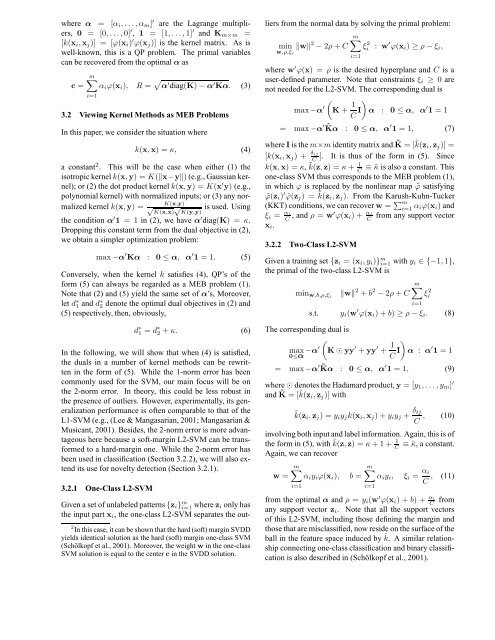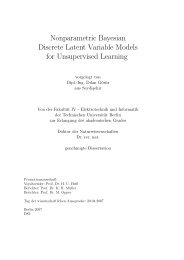Very Large SVM Training using Core Vector Machines
Very Large SVM Training using Core Vector Machines
Very Large SVM Training using Core Vector Machines
You also want an ePaper? Increase the reach of your titles
YUMPU automatically turns print PDFs into web optimized ePapers that Google loves.
where α = [αi, . . .,αm] ′ are the Lagrange multipliers,<br />
0 = [0, . . .,0] ′ , 1 = [1, . . . , 1] ′ and Km×m =<br />
[k(xi,xj)] = [ϕ(xi) ′ ϕ(xj)] is the kernel matrix. As is<br />
well-known, this is a QP problem. The primal variables<br />
can be recovered from the optimal α as<br />
c =<br />
m<br />
αiϕ(xi), R = α ′ diag(K) − α ′ Kα. (3)<br />
i=1<br />
3.2 Viewing Kernel Methods as MEB Problems<br />
In this paper, we consider the situation where<br />
k(x,x) = κ, (4)<br />
a constant2 . This will be the case when either (1) the<br />
isotropic kernel k(x,y) = K(x−y) (e.g., Gaussian kernel);<br />
or (2) the dot product kernel k(x,y) = K(x ′ y) (e.g.,<br />
polynomial kernel) with normalized inputs; or (3) any nor-<br />
K(x,y)<br />
malized kernel k(x,y) =<br />
√ K(x,x) √ K(y,y) is used. Using<br />
the condition α ′ 1 = 1 in (2), we have α ′ diag(K) = κ.<br />
Dropping this constant term from the dual objective in (2),<br />
we obtain a simpler optimization problem:<br />
max −α ′ Kα : 0 ≤ α, α ′ 1 = 1. (5)<br />
Conversely, when the kernel k satisfies (4), QP’s of the<br />
form (5) can always be regarded as a MEB problem (1).<br />
Note that (2) and (5) yield the same set of α’s, Moreover,<br />
let d∗ 1 and d∗2 denote the optimal dual objectives in (2) and<br />
(5) respectively, then, obviously,<br />
d ∗ 1 = d ∗ 2 + κ. (6)<br />
In the following, we will show that when (4) is satisfied,<br />
the duals in a number of kernel methods can be rewritten<br />
in the form of (5). While the 1-norm error has been<br />
commonly used for the <strong>SVM</strong>, our main focus will be on<br />
the 2-norm error. In theory, this could be less robust in<br />
the presence of outliers. However, experimentally, its generalization<br />
performance is often comparable to that of the<br />
L1-<strong>SVM</strong> (e.g., (Lee & Mangasarian, 2001; Mangasarian &<br />
Musicant, 2001). Besides, the 2-norm error is more advantageous<br />
here because a soft-margin L2-<strong>SVM</strong> can be transformed<br />
to a hard-margin one. While the 2-norm error has<br />
been used in classification (Section 3.2.2), we will also extend<br />
its use for novelty detection (Section 3.2.1).<br />
3.2.1 One-Class L2-<strong>SVM</strong><br />
Given a set of unlabeled patterns {zi} m i=1 where zi only has<br />
the input part xi, the one-class L2-<strong>SVM</strong> separates the out-<br />
2 In this case, it can be shown that the hard (soft) margin SVDD<br />
yields identical solution as the hard (soft) margin one-class <strong>SVM</strong><br />
(Schölkopf et al., 2001). Moreover, the weight w in the one-class<br />
<strong>SVM</strong> solution is equal to the center c in the SVDD solution.<br />
liers from the normal data by solving the primal problem:<br />
min w<br />
w,ρ,ξi<br />
2 − 2ρ + C<br />
m<br />
ξ 2 i : w ′ ϕ(xi) ≥ ρ − ξi,<br />
i=1<br />
where w ′ ϕ(x) = ρ is the desired hyperplane and C is a<br />
user-defined parameter. Note that constraints ξi ≥ 0 are<br />
not needed for the L2-<strong>SVM</strong>. The corresponding dual is<br />
max −α ′<br />
<br />
K + 1<br />
C I<br />
<br />
α : 0 ≤ α, α ′ 1 = 1<br />
= max −α ′ ˜Kα : 0 ≤ α, α ′ 1 = 1, (7)<br />
whereI is the m×m identity matrix and ˜K = [ ˜ k(zi,zj)] =<br />
[k(xi,xj) + δij<br />
C ]. It is thus of the form in (5). Since<br />
k(x,x) = κ, ˜ k(z,z) = κ + 1<br />
C ≡ ˜κ is also a constant. This<br />
one-class <strong>SVM</strong> thus corresponds to the MEB problem (1),<br />
in which ϕ is replaced by the nonlinear map ˜ϕ satisfying<br />
˜ϕ(zi) ′ ˜ϕ(zj) = ˜ k(zi,zj). From the Karush-Kuhn-Tucker<br />
(KKT) conditions, we can recover w = m i=1 αiϕ(xi) and<br />
ξi = αi<br />
C , and ρ = w′ ϕ(xi) + αi<br />
C from any support vector<br />
xi.<br />
3.2.2 Two-Class L2-<strong>SVM</strong><br />
Given a training set {zi = (xi, yi)} m i=1 with yi ∈ {−1, 1},<br />
the primal of the two-class L2-<strong>SVM</strong> is<br />
minw,b,ρ,ξi w 2 + b 2 − 2ρ + C<br />
The corresponding dual is<br />
max<br />
0≤α −α′<br />
m<br />
i=1<br />
s.t. yi(w ′ ϕ(xi) + b) ≥ ρ − ξi. (8)<br />
<br />
K ⊙ yy ′ + yy ′ + 1<br />
C I<br />
ξ 2 i<br />
<br />
α : α ′ 1 = 1<br />
= max −α ′ ˜Kα : 0 ≤ α, α ′ 1 = 1, (9)<br />
where ⊙ denotes the Hadamard product, y = [y1, . . . , ym] ′<br />
and ˜ K = [ ˜ k(zi,zj)] with<br />
˜k(zi,zj) = yiyjk(xi,xj) + yiyj + δij<br />
, (10)<br />
C<br />
involving both input and label information. Again, this is of<br />
the form in (5), with ˜ k(z,z) = κ + 1 + 1<br />
C ≡ ˜κ, a constant.<br />
Again, we can recover<br />
m<br />
m<br />
w = αiyiϕ(xi), b = αiyi, ξi = αi<br />
, (11)<br />
C<br />
i=1<br />
i=1<br />
from the optimal α and ρ = yi(w ′ ϕ(xi) + b) + αi<br />
C from<br />
any support vector zi. Note that all the support vectors<br />
of this L2-<strong>SVM</strong>, including those defining the margin and<br />
those that are misclassified, now reside on the surface of the<br />
ball in the feature space induced by ˜ k. A similar relationship<br />
connecting one-class classification and binary classification<br />
is also described in (Schölkopf et al., 2001).

















